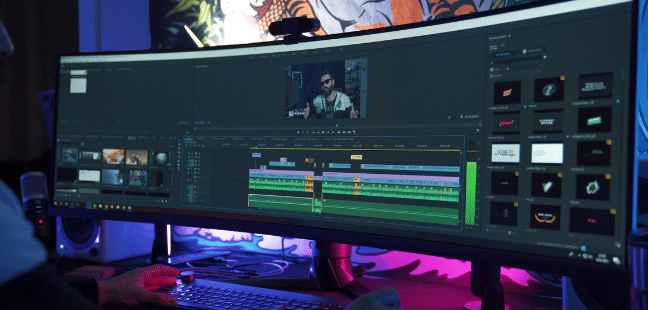Even though Netflix and other streaming platforms may spring to mind first, subtitling is not limited to the entertainment industry. Alongside TV series, movies and documentaries, subtitling is also important for BtoB video content (product or services demonstrations, tutorials, webinars, interviews, etc.). Today, videos are one of the most efficient and fastest-growing communication channels and have other purposes besides entertainment: training, marketing campaigns, advertising, and even recruitment.
Slator has estimated that the video localization services and technologies market size was USD 4.97bn in 2021, which represents 9.3% of the market size of the global language services industry this same year. Let’s take a look at some key figures to understand why video content is crucial:
- 86% of businesses use videos as a marketing tool,
- Over 50% of consumers prefer to watch videos from brands they support,
- Facebook users find videos 5 times more engaging than images,
- 82% of global internet traffic comes from video streaming or downloads,
- 85% of videos on Facebook are watched on mobile phones without sound and with the subtitles on,
- 95% of a message is retained when displayed in a video format, compared to 10% in a written format,
- 88% more time is spent browsing websites with videos.
It’s no wonder why video localization requests are booming!
What sets subtitling apart from other linguistic services? What challenges does it pose? Is specific training required for subtitling? What skills and software are recommended for providing subtitling services?
Let’s dive into the art of subtitling:
Why Subtitling Is Not Like Any Other Translation Service
It is often (wrongly) said that any translator can handle a subtitling project because they are naturally “good” at it. Even though professional subtitlers all have qualifications in translation or languages, subtitling goes beyond mere translation.
Subtitling involves putting the words someone is saying on-screen into written format. However, the constraints placed on subtitle creation (duration, number of lines, number of characters per line, etc.) make it more challenging in some ways than conventional translation.
Based on the average viewer reading ability, there should only be 12 to 15 characters of text per second of screen time. Of course, some dialogs are longer than others, so the subtitler cannot always translate everything. If they were to include everything, it would be impossible to read the subtitles and the audience could be distracted from what is happening on-screen.
So, translation skills are a good start, but they’re not enough. You must be familiar with the audiovisual rules.

What Skills and Training Courses Are Required for Subtitling?
Subtitling requires both excellent knowledge of the source language and the ability to adapt the target language to the prescribed line length. So, you must know how to appropriately translate cultural references, puns and expressions. Many jokes, references and abbreviations don’t have direct translations, but a thorough knowledge of your language pairs will always get you closer to the real meaning.
To give you an idea, the following expression is provided in different languages alongside its literal meaning:
|
Language |
Translation |
Literal meaning of translation |
|
English |
To have other fish to fry Or To have better things to do |
|
|
Italian |
Avere altre gatte da pelare |
Avoir d’autres chats à écorcher |
|
Spanish |
Tener cosas más importantes que hacer |
To have more important things to do |
|
French |
Avoir d’autres chats à fouetter |
To have other cats to whip |
You must also learn to prioritize essential information in the source audiovisual content and accept that some information may be left aside. The ability to paraphrase is key, as is creativity and problem-solving using language.
You must also use specific software for audiovisual translations, subtitling and captioning, such as Wincaps, Aegisub, EZTitles and CaptionHub. You can take a formal course to learn how to use these tools and practice using them with guidance and feedback from teachers and professional subtitlers with a lot of industry experience.
University courses and optional learning modules in audiovisual translation or subtitling are a great way to quickly acquire and practice the skill whilst receiving feedback to master the craft. For example, the Master in Audiovisual Translation and Localization (UAM-UCM) at the Complutense University of Madrid, or the Master in Audiovisual Translation at the Institute of Translators, Interpreters and International Relations, based in Strasbourg, France.

How Does Subtitling Work?
There are specific steps to follow for adding subtitles to a video. Generally, the subtitles need to be spotted first. They are usually created in the source language initially, either automatically with ASR (automatic speech recognition) or semi-automatically (ASR with human revision) so that they match the start and end times of the speech in the scenes.
Attention must be paid to rapidly changing shots; subtitles must never overlap. This must be carried out in accordance with the appropriate standards (max. and min. subtitle durations, etc.). The subtitles are then translated. This involves condensing and translating the meaning of the speech, as well as synchronizing the displayed text in the target language with the audio track, because the target language text length may differ from the source language.
When it comes to BtoB video content videos, it is very important to consult the client to ensure that any specific terminology they use in their company is used appropriately in the subtitles. If they have any stylistic requirements, these need to be incorporated too. Generally speaking, the subtitler and the end client should be in contact throughout the process so that any queries can be resolved.

Subtitling, Dubbing, Voiceover: What Are the Differences?
Subtitling and dubbing options can vary per country, content and budget, and subtitles are not always available in all languages. Some regions will choose subtitles over dubbing, such as the Nordics and English-speaking countries. Others like France and most European countries will prefer dubbing. However, preferences are constantly evolving and depend to a great extent on the type of content and the platform where the video is hosted.
There is often confusion between these terms, as although they all belong to multimedia translation, they differ in terms of process and format.
Dubbing and voiceover differ from subtitling in that they are techniques for recording spoken messages for audiences. They are often used when special messages are involved because they are much more effective in conveying emotions.
Voiceover is recorded audio material that covers the original audio, whereas dubbing replaces the source audio with an audio recorded in the target language. Dubbing involves more creative methods as dubbing specialists are able to customize the translations and adapt them to the physical movements of actors on-screen to achieve lip-sync and a more natural experience, as if the actors were speaking directly in the audience target language.
Today, technology is making huge strides in this field. Voiceover and dubbing can also be achieved with synthetic voices, created from human voices, to achieve a similar result that can be adapted for specific types of content.
If you want more tips and information about subtitling for movies and corporate videos, take a look at the recording of Acolad Community’s online roundtable on this topic with freelance translator and subtitler, Silvia Gallico. We discussed software, the differences with “traditional” translation, and how to gain subtitling experience.
The Challenges of Subtitling Today: Quality and Reliability
Regardless of the services you provide, quality should always be your top priority, and video is no exception. Video content has become an important trend and the customers you work for expect to see professional, high-quality videos.
When discussing subtitling, two major concerns that threaten the sector are raised: cheap subtitles and pirates (fansubbers). Indeed, fansubbing on the Internet is illegal because the translation of audiovisual works without the permission of those who own the rights is considered an infringement. It is said that amateurs are indirectly competing with professionals, since the majority of Internet users watch streamed video content.
How many times have you encountered bad subtitles on the Internet? Netflix and other streaming services have been in the news multiple times due to subtitling mistakes in games and TV content, which can be embarrassing and take away from the viewer’s overall experience. Here are some notorious examples:

To beat the fansubbers, you need to guarantee high-quality subtitling. But how? If we sum up, you need:
- A native speaker of the target language,
- Training in and/or experience with subtitling,
- The appropriate subtitle standards regarding duration and characters per line,
- The use of professional subtitling software to produce the best quality subtitles.
If you have more tips and best practices to share with the community, don’t hesitate to write them in our Facebook group chat!
Don’t forget to subscribe to our monthly newsletter if you haven’t already to keep up to date with upcoming events and training sessions hosted by experts from Acolad.
Sources:
- ADG Creative – By 2021, 82% of consumer internet traffic will be video, are we ready? https://www.adgcreative.net/resources/by-2021-82-of-consumer-internet-traffic-will-be-video-are-we-ready/
- American Press Institute – 85 percent of Facebook videos are watched without sound https://www.americanpressinstitute.org/need-to-know/try-this-at-home/85-percent-facebook-videos-watched-without-sound/
- Forbes – How To Incorporate Video Into Your Social Media Strategy https://www.forbes.com/sites/yec/2017/07/13/how-to-incorporate-video-into-your-social-media-strategy/
- Invideo – 135 Video Marketing Statistics You Can’t Ignore in 2022 https://invideo.io/blog/video-marketing-statistics/
- Nimdzi – 5 tips to get the most out of your video localization strategy https://www.nimdzi.com/video-localization-strategy/
- Oberlo – 10 video marketing statistics that you need to know in 2022 [infographic] https://www.oberlo.com/blog/video-marketing-statistics
- Slator – 2021 video localization report https://slator.com/slator-2021-video-localization-report/
- Tubular Insights – Facebook users find video 5x more engaging than images https://tubularinsights.com/facebook-users-video-more-engaging-images/
- Wyzowl – video marketing statistics 2022 https://bit.ly/3OFNmDX
